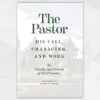Book Review: The Post-Quarantine Church, by Thom Rainer
Thom S. Rainer, The Post-Quarantine Church: Six Urgent Challenges & Opportunities that will Determine the Future of Your Congregation. Tyndale Momentum, 2020. 115 pages.
At the end of a long, hard year, a short, easy read might be all that most of us can handle—especially if that book is about the pandemic. So when my friend Steve informed me that our local pastors’ association would be reading and discussing The Post-Quarantine Church, I’ll admit that I was glad for the book’s brevity. At just over 100 pages, Rainer’s book is short enough that you might even forget you were wearing your mask the whole time you were reading it.
In his conclusion, Rainer notes, “Without a doubt, the world has changed. Without a doubt, Western culture has shifted; and it has shifted largely against churches. Without a doubt, most church leaders have not been trained and equipped for this new season” (110). But far from being pessimistic about the future of the church “post-quarantine,” Rainer sees a multitude of opportunities for Christ-exalting, Spirit-empowered, Word-centered, church-based ministry.
Rainer doesn’t attempt to provide a lot of answers in the book. He understands that no one knows for sure what the long-term effects of the pandemic will be on churches and Christian ministry. What he does attempt to do—and does fairly well—is raise good questions for church leaders to prayerfully consider. He does so in the form of six challenges:
- Gather Differently and Better
- Seize Your Opportunity to Reach the Digital World
- Reconnect with the Community Near Your Church
- Take Prayer to a New and Powerful Level
- Rethink Your Facilities for Emerging Opportunities
- Make Lasting Changes that Will Make a Differences
Just as the world was never the same after 9/11, the world is already different than it was a year ago. The expression is clichéd at this point, but we have indeed entered “the new normal.” Asking and answering good questions, therefore, will largely determine our ministry effectiveness in the months and years ahead. What follows are three big questions that Rainer’s book raised for me and my church.
HOW WILL WE APPROACH CHURCH PROGRAMMING?
Prior to the pandemic, many program-driven churches were simply asking too much of their members—program-heavy ministries leave little time for members to engage in family discipleship, intentional evangelism, or hospitality. In these ministries faithful church members often burn out and even feel guilty over what they aren’t doing, even as their calendars are filled with church activities.
Perhaps one good outcome of the pandemic is that it provided churches with an opportunity for a hard reset—an opportunity to consider whether their ministry programs were worthwhile.
Plenty of programs can, and should, remain a part of church life. Other programs were already dying, or needed to die, because they weren’t contributing to the mission of the church. Rainer rightly sees the pandemic as an opportunity to evaluate everything we’re doing, and only restart the programs that move the ball down the field.
HOW WILL WE USE OUR CHURCH FACILITIES?
According to Rainer, most churches have a 10% occupancy rate—that is, their facilities are not being used at all 90% of the time. That’s poor stewardship—and a lot of the time, it’s because church leaders are afraid to open the doors to the community for fear of people coming in and “messing up” the beautiful facilities we’ve built and paid for.
But the pandemic has revealed what was true all along—the church is the people, not the building. The church building is a tool for ministry, not an end in itself.
When we view our facilities as tools, doors open (forgive the pun) to meet needs and share Christ in our community. Rainer notes, “The key is to see the church building from the perspective of the community rather than their church members” (75). That doesn’t mean we prioritize the community over the members of the church, but that the needs of the community are considered when we make decisions about what facilities to buy or build, and how to use those facilities to reach our neighbors for Christ.
THE MILLION-DOLLAR QUESTION: WHAT WILL WE DO ABOUT LIVESTREAMING?
I have no idea what the actual numbers are, but I would guess that prior to March 2020, most churches did not livestream their worship services. My own church—a young, tech-savvy church in a university town —didn’t livestream ours!
A mere nine months later, I would guess that of the vast majority of churches do livestream their worship services. Of all the changes that have taken place over the past year, you could make the case that nothing will have a greater effect, for better or for worse, on local church ministry than this dramatic shift to livestreaming worship services.
Speaking with a group of pastors last week, I shared that I had no idea what to do about our livestream once the pandemic is under control. My first instinct is to stop offering it as soon as nearly everyone is comfortable worshiping in person again. I agree with Rainer: “I am unapologetic about advocating faithful attendance. The church gathered, whether it’s in a building, in a home, or out in a field.” (73). I believe that regularly gathering in person to hear the Word read and proclaimed, to sing and to pray, to fellowship and to serve, is simply not optional for Christians.
At the same time, every church has older men and women who are unable to gather consistently with the church. Families get sick throughout the year and must remain at home on Sundays. First responders regularly have to work on the Lord’s Day. Are we so committed to the principle of gathering in person that we would remove the option for these brothers and sisters to view, and in some sense, participate, in our worship services? 9Marks readers may well give different answers to this question. Rainer says to keep the livestream going. Mark Dever would say to turn it off—or never start one in the first place! Depending on where you come down, you’ll regard Rainer’s answer as a strength or weakness of the book. But we must ask the above question, carefully and prayerfully answer it, and then walk forward in humble faith that we made the right call for our local church.
SHOULD YOU READ THIS BOOK?
In the book’s introduction, Rainer recounts talking to a pastor who told him that he couldn’t wait for things to get back to normal. Rainer replied that he “didn’t think we would ever return to the pre-quarantine normal” (7). I’m with Rainer. I don’t think things are ever going to go back to the way they used to be.
Consultants are paid to come into an organization from the outside and point out things that may not be obvious to those on the inside. They are paid, essentially, to ask good questions. Not every question raised by Rainer will be relevant to your church. But many of them will be and answering those questions will help you minister more faithfully in the next season. And I think that’s worth a few bucks.








